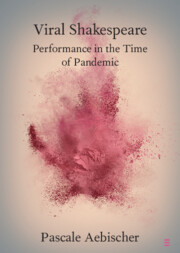59 results

Viral Shakespeare
- Performance in the Time of Pandemic
-
- Published online:
- 11 December 2021
- Print publication:
- 20 January 2022
-
- Element
- Export citation
Chapter 2 - Dominic Dromgoole’s The Tempest (2016): Labour, Technology and the Gender of Theatrical Magic
- from Part I - Candlelight and Architecture at the Sam Wanamaker Playhouse
-
- Book:
- Shakespeare, Spectatorship and the Technologies of Performance
- Published online:
- 10 April 2020
- Print publication:
- 30 April 2020, pp 66-84
-
- Chapter
- Export citation
Chapter 6 - Offstage Dynamics and the Virtual Public Sphere in Cheek by Jowl’s Live Stream of Measure for Measure (2015)
- from Part III - ‘Invisible’ Technology and ‘Liveness’ in Digital Theatre Broadcasting
-
- Book:
- Shakespeare, Spectatorship and the Technologies of Performance
- Published online:
- 10 April 2020
- Print publication:
- 30 April 2020, pp 191-206
-
- Chapter
- Export citation
How to Read This Book
-
- Book:
- Shakespeare, Spectatorship and the Technologies of Performance
- Published online:
- 10 April 2020
- Print publication:
- 30 April 2020, pp xv-xvi
-
- Chapter
- Export citation
Index
-
- Book:
- Shakespeare, Spectatorship and the Technologies of Performance
- Published online:
- 10 April 2020
- Print publication:
- 30 April 2020, pp 236-242
-
- Chapter
- Export citation
Figures
-
- Book:
- Shakespeare, Spectatorship and the Technologies of Performance
- Published online:
- 10 April 2020
- Print publication:
- 30 April 2020, pp vii-ix
-
- Chapter
- Export citation
Introduction
-
- Book:
- Shakespeare, Spectatorship and the Technologies of Performance
- Published online:
- 10 April 2020
- Print publication:
- 30 April 2020, pp 1-32
-
- Chapter
- Export citation
Copyright page
-
- Book:
- Shakespeare, Spectatorship and the Technologies of Performance
- Published online:
- 10 April 2020
- Print publication:
- 30 April 2020, pp iv-iv
-
- Chapter
- Export citation
Chapter 3 - Stanislavski in the Closet: Joe Hill-Gibbins’ Edward II (National Theatre, 2013)
- from Part II - Digital Technologies and Early Modern Drama at the National Theatre and the RSC
-
- Book:
- Shakespeare, Spectatorship and the Technologies of Performance
- Published online:
- 10 April 2020
- Print publication:
- 30 April 2020, pp 89-107
-
- Chapter
- Export citation
Acknowledgements
-
- Book:
- Shakespeare, Spectatorship and the Technologies of Performance
- Published online:
- 10 April 2020
- Print publication:
- 30 April 2020, pp xi-xiv
-
- Chapter
- Export citation
Part II - Digital Technologies and Early Modern Drama at the National Theatre and the RSC
-
- Book:
- Shakespeare, Spectatorship and the Technologies of Performance
- Published online:
- 10 April 2020
- Print publication:
- 30 April 2020, pp 85-148
-
- Chapter
- Export citation
Contents
-
- Book:
- Shakespeare, Spectatorship and the Technologies of Performance
- Published online:
- 10 April 2020
- Print publication:
- 30 April 2020, pp v-vi
-
- Chapter
- Export citation
Tables
-
- Book:
- Shakespeare, Spectatorship and the Technologies of Performance
- Published online:
- 10 April 2020
- Print publication:
- 30 April 2020, pp x-x
-
- Chapter
- Export citation
Chapter 4 - ‘Tech-Enabled’ Theatre at the RSC: Digital Performance and Gregory Doran’s Tempest (RSC, 2016)
- from Part II - Digital Technologies and Early Modern Drama at the National Theatre and the RSC
-
- Book:
- Shakespeare, Spectatorship and the Technologies of Performance
- Published online:
- 10 April 2020
- Print publication:
- 30 April 2020, pp 108-148
-
- Chapter
- Export citation
Chapter 5 - Hamlet in Parts: Robin Lough’s RSC Live Cinema Broadcast of Simon Godwin’s Hamlet (8 June 2016)
- from Part III - ‘Invisible’ Technology and ‘Liveness’ in Digital Theatre Broadcasting
-
- Book:
- Shakespeare, Spectatorship and the Technologies of Performance
- Published online:
- 10 April 2020
- Print publication:
- 30 April 2020, pp 157-190
-
- Chapter
- Export citation
Part I - Candlelight and Architecture at the Sam Wanamaker Playhouse
-
- Book:
- Shakespeare, Spectatorship and the Technologies of Performance
- Published online:
- 10 April 2020
- Print publication:
- 30 April 2020, pp 33-84
-
- Chapter
- Export citation
Part III - ‘Invisible’ Technology and ‘Liveness’ in Digital Theatre Broadcasting
-
- Book:
- Shakespeare, Spectatorship and the Technologies of Performance
- Published online:
- 10 April 2020
- Print publication:
- 30 April 2020, pp 149-206
-
- Chapter
- Export citation
Bibliography
-
- Book:
- Shakespeare, Spectatorship and the Technologies of Performance
- Published online:
- 10 April 2020
- Print publication:
- 30 April 2020, pp 219-235
-
- Chapter
- Export citation
Concluding Most Obscenely: Offstage Technophelias
-
- Book:
- Shakespeare, Spectatorship and the Technologies of Performance
- Published online:
- 10 April 2020
- Print publication:
- 30 April 2020, pp 207-218
-
- Chapter
- Export citation
Chapter 1 - Dominic Dromgoole’s The Changeling (2015): Social Division and Anamorphic Vision
- from Part I - Candlelight and Architecture at the Sam Wanamaker Playhouse
-
- Book:
- Shakespeare, Spectatorship and the Technologies of Performance
- Published online:
- 10 April 2020
- Print publication:
- 30 April 2020, pp 51-65
-
- Chapter
- Export citation

